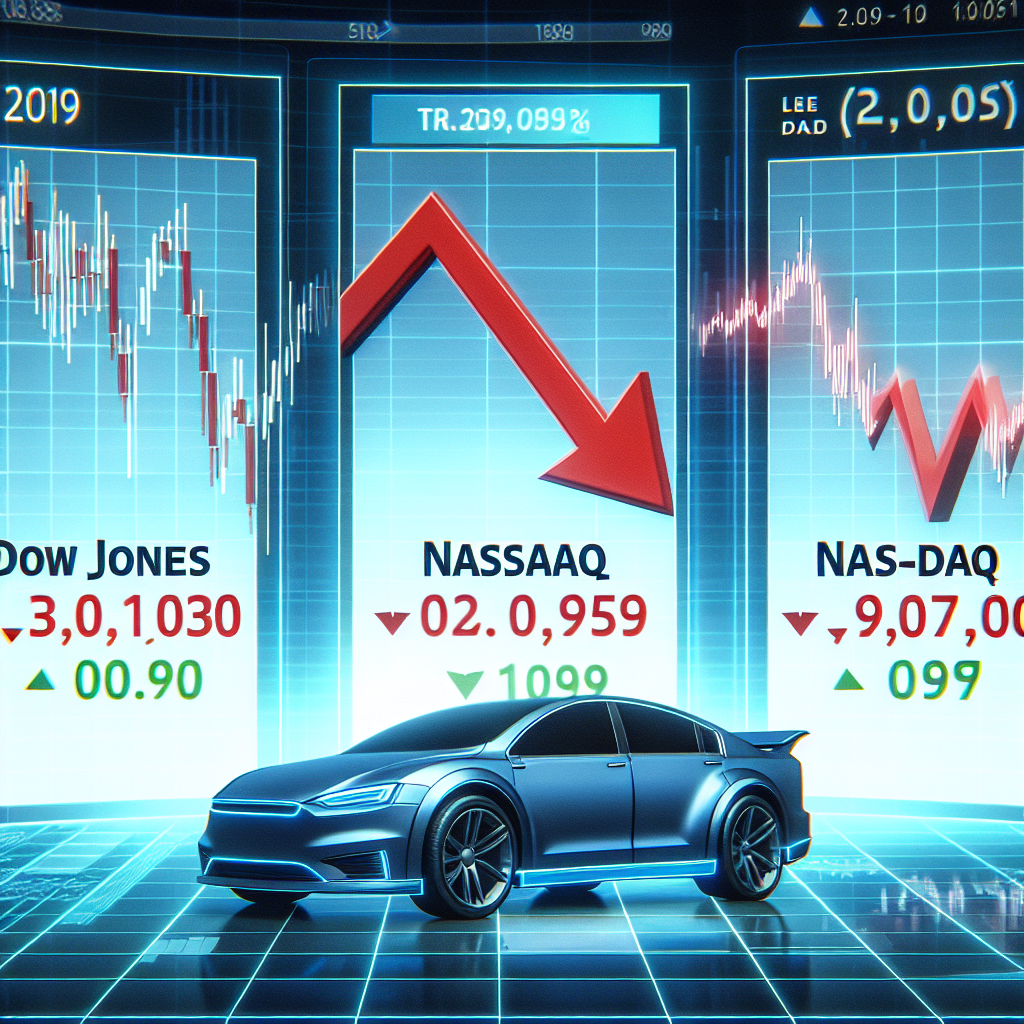“Market Pulse: Dow Dips, Nasdaq Climbs, Tesla Charges Ahead!”
Introduction
In the latest market update, the Dow Jones Industrial Average experienced a slight decline, while the Nasdaq Composite saw an uptick, driven by notable gains in technology stocks, particularly Tesla. This divergence in market performance highlights the ongoing volatility and sector-specific dynamics influencing investor sentiment. As traditional industries represented in the Dow face headwinds, the tech-heavy Nasdaq benefits from robust performances by key players like Tesla, which continues to capture investor attention with its innovative advancements and strong market position. This mixed market movement underscores the complex landscape of the current economic environment, where growth prospects and sectoral shifts play pivotal roles in shaping market trajectories.
Analysis Of Dow’s Recent Decline: Factors And Implications
In recent weeks, the financial markets have exhibited a mixed performance, with the Dow Jones Industrial Average experiencing a decline while the Nasdaq Composite has shown resilience, buoyed by gains in technology stocks, particularly Tesla. This divergence in market behavior prompts a closer examination of the factors contributing to the Dow’s recent downturn and the broader implications for investors and the economy.
To begin with, the Dow’s decline can be attributed to several interrelated factors. One significant element is the ongoing concern over inflationary pressures, which have been exacerbated by supply chain disruptions and rising energy costs. These inflationary trends have led to increased speculation about potential interest rate hikes by the Federal Reserve, creating uncertainty among investors. As a result, sectors that are sensitive to interest rate changes, such as financials and industrials, have experienced downward pressure, contributing to the Dow’s overall decline.
Moreover, geopolitical tensions have also played a role in the Dow’s recent performance. The global economic landscape remains fraught with uncertainty due to ongoing trade disputes and political instability in various regions. These geopolitical factors have heightened market volatility, leading investors to adopt a more cautious approach, particularly in sectors that are heavily reliant on international trade and exports.
In contrast, the Nasdaq’s rise, led by gains in technology stocks like Tesla, highlights the market’s continued confidence in the tech sector’s growth potential. Tesla, in particular, has been a standout performer, driven by strong quarterly earnings and optimistic projections for future growth. The company’s advancements in electric vehicle technology and expansion into new markets have bolstered investor sentiment, contributing to the Nasdaq’s upward trajectory.
Furthermore, the tech sector’s resilience can be attributed to its perceived ability to weather economic uncertainties better than other sectors. Companies within this sector often possess robust balance sheets and are less susceptible to the immediate impacts of inflation and interest rate fluctuations. This perception has made technology stocks an attractive option for investors seeking growth opportunities amidst broader market volatility.
The implications of these market dynamics are multifaceted. For investors, the divergence between the Dow and Nasdaq underscores the importance of diversification in investment portfolios. By spreading investments across various sectors, investors can mitigate risks associated with sector-specific downturns and capitalize on growth opportunities in outperforming areas.
Additionally, the current market environment highlights the need for a nuanced understanding of macroeconomic factors and their potential impact on different sectors. Investors must remain vigilant and informed about developments in inflation, interest rates, and geopolitical events, as these elements can significantly influence market performance.
From a broader economic perspective, the Dow’s decline and the Nasdaq’s rise reflect the ongoing transition in the global economy towards technology-driven growth. As traditional industries face challenges from technological advancements and shifting consumer preferences, the tech sector’s prominence is likely to continue growing. This shift presents both opportunities and challenges for policymakers, who must balance fostering innovation with addressing the economic disruptions that may arise from such transitions.
In conclusion, the recent market trends, characterized by the Dow’s decline and the Nasdaq’s rise, are indicative of the complex interplay between macroeconomic factors, sector-specific dynamics, and investor sentiment. As the financial landscape continues to evolve, staying informed and adaptable will be crucial for investors and policymakers alike in navigating the challenges and opportunities that lie ahead.
Nasdaq’s Resilience: How Tech Stocks Are Driving Growth
In recent market developments, the Nasdaq has demonstrated remarkable resilience, contrasting with the Dow’s slight decline. This divergence underscores the dynamic nature of the stock market, where different sectors can experience varying fortunes. The Nasdaq’s upward trajectory has been significantly bolstered by the robust performance of technology stocks, with Tesla emerging as a prominent leader in driving these gains. As investors navigate the complexities of the current economic landscape, the technology sector continues to offer a beacon of growth and innovation.
The Nasdaq’s resilience can be attributed to several key factors, chief among them being the enduring strength of technology companies. In an era where digital transformation is paramount, tech firms are at the forefront of innovation, providing solutions that cater to an increasingly digital world. This has resulted in sustained investor confidence, as evidenced by the recent uptick in the Nasdaq index. Companies like Tesla have played a pivotal role in this narrative, showcasing the potential for growth even amidst broader market uncertainties.
Tesla’s performance, in particular, has been a significant contributor to the Nasdaq’s rise. The electric vehicle manufacturer has consistently demonstrated its ability to innovate and capture market share, which has translated into substantial stock gains. Tesla’s advancements in battery technology, autonomous driving, and global expansion have positioned it as a leader in the automotive industry, further solidifying its status as a key player in the tech-driven market rally. As a result, Tesla’s stock has become a bellwether for investor sentiment in the technology sector.
Moreover, the broader technology sector has benefited from a favorable macroeconomic environment. Low interest rates and a focus on digital infrastructure have created a conducive atmosphere for tech companies to thrive. This has encouraged both institutional and retail investors to allocate capital towards technology stocks, seeking to capitalize on their growth potential. The ongoing shift towards remote work, e-commerce, and cloud computing has further accelerated this trend, reinforcing the sector’s resilience in the face of economic challenges.
In addition to Tesla, other technology giants have also contributed to the Nasdaq’s strength. Companies such as Apple, Amazon, and Microsoft continue to report strong earnings, driven by their ability to adapt to changing consumer behaviors and technological advancements. These firms have not only weathered the storm of economic uncertainty but have also emerged stronger, leveraging their scale and innovation to capture new opportunities. This collective performance has provided a solid foundation for the Nasdaq’s upward momentum.
While the Dow’s dip may raise concerns about broader market volatility, the Nasdaq’s rise offers a counterbalance, highlighting the importance of diversification in investment portfolios. As the market continues to evolve, investors are increasingly recognizing the value of technology stocks as a hedge against traditional market fluctuations. This shift in investment strategy underscores the growing influence of the tech sector in shaping market dynamics.
In conclusion, the Nasdaq’s resilience, driven by the strength of technology stocks and led by Tesla’s impressive gains, reflects the sector’s pivotal role in driving market growth. As the world becomes more interconnected and reliant on digital solutions, technology companies are well-positioned to continue their upward trajectory. Investors, therefore, remain optimistic about the potential for sustained growth in the tech sector, even as they navigate the complexities of the broader economic landscape.
Tesla’s Role In Nasdaq’s Surge: A Closer Look
In recent market developments, the Dow Jones Industrial Average experienced a slight dip, while the Nasdaq Composite Index saw a notable rise, largely driven by gains in Tesla’s stock. This divergence in performance between the two indices highlights the unique dynamics at play within the current market environment. As investors navigate these fluctuations, it becomes essential to understand the factors contributing to Tesla’s influence on the Nasdaq’s upward trajectory.
Tesla, a prominent player in the electric vehicle industry, has consistently captured the attention of investors and analysts alike. Its innovative approach to sustainable transportation and energy solutions has positioned it as a leader in the sector. Recently, Tesla’s stock has experienced a surge, contributing significantly to the Nasdaq’s overall performance. This rise can be attributed to several key factors that have bolstered investor confidence in the company.
Firstly, Tesla’s strong quarterly earnings report has played a crucial role in boosting its stock price. The company reported higher-than-expected revenue and profit margins, driven by increased vehicle deliveries and robust demand for its products. This positive financial performance has reassured investors about Tesla’s growth prospects, leading to increased buying activity in the stock market. Furthermore, Tesla’s strategic expansion into international markets has also contributed to its recent success. The company’s efforts to establish a strong presence in regions such as Europe and Asia have opened up new avenues for growth. By tapping into these markets, Tesla has been able to diversify its revenue streams and reduce its reliance on the North American market. This global expansion strategy has not only enhanced Tesla’s market position but has also instilled confidence in investors regarding its long-term sustainability.
In addition to its financial performance and global expansion, Tesla’s continuous focus on innovation has further solidified its standing in the market. The company’s commitment to advancing electric vehicle technology and developing cutting-edge features has set it apart from its competitors. Tesla’s investments in research and development have resulted in breakthroughs such as improved battery efficiency and autonomous driving capabilities. These technological advancements have not only attracted consumers but have also garnered attention from investors seeking exposure to the future of transportation.
Moreover, Tesla’s role in the broader transition towards renewable energy has resonated with environmentally conscious investors. As the world increasingly shifts towards sustainable practices, companies like Tesla that prioritize clean energy solutions are gaining favor among investors. This alignment with global sustainability trends has positioned Tesla as a key player in the green economy, further driving its stock price upward.
While Tesla’s performance has undoubtedly contributed to the Nasdaq’s rise, it is important to consider the broader market context. The technology sector, in general, has been experiencing a resurgence, with several tech giants reporting strong earnings and positive outlooks. This sector-wide momentum has provided additional support to the Nasdaq, amplifying the impact of Tesla’s gains.
In conclusion, Tesla’s role in the Nasdaq’s recent surge can be attributed to a combination of strong financial performance, strategic global expansion, continuous innovation, and alignment with sustainability trends. As the company continues to navigate the evolving market landscape, its influence on the Nasdaq is likely to persist. Investors and analysts will undoubtedly keep a close eye on Tesla’s developments, as its performance remains a key driver of market sentiment and a barometer for the broader technology sector.
Comparing Market Trends: Dow Vs. Nasdaq Performance

In the ever-evolving landscape of financial markets, the performance of major indices such as the Dow Jones Industrial Average and the Nasdaq Composite often serves as a barometer for investor sentiment and economic health. Recently, these indices have exhibited divergent trends, with the Dow experiencing a slight dip while the Nasdaq has shown a notable rise, largely driven by gains in technology stocks, particularly Tesla. This divergence underscores the distinct characteristics and sectoral compositions of these indices, offering insights into broader market dynamics.
The Dow Jones Industrial Average, often referred to simply as the Dow, is a price-weighted index comprising 30 large, publicly-owned companies based in the United States. It is traditionally seen as a reflection of the industrial and financial sectors, with significant representation from companies in these areas. Recently, the Dow has experienced a modest decline, attributed to a combination of factors including concerns over rising interest rates, geopolitical tensions, and mixed economic data. These elements have collectively contributed to a cautious investor outlook, particularly affecting sectors such as manufacturing and finance, which are heavily represented in the Dow.
In contrast, the Nasdaq Composite, a market-capitalization-weighted index, is heavily skewed towards technology and growth-oriented companies. This index has recently seen an upward trajectory, buoyed by strong performances from tech giants. Notably, Tesla has been a significant contributor to the Nasdaq’s gains. The electric vehicle manufacturer has seen its stock price surge due to a combination of robust quarterly earnings, optimistic future growth projections, and increased investor confidence in its innovative capabilities. Tesla’s performance highlights the broader trend of investor enthusiasm for technology and innovation-driven companies, which continue to capture significant market attention.
The contrasting performances of the Dow and Nasdaq can be attributed to their differing sectoral compositions and the current economic environment. While the Dow’s decline reflects broader economic uncertainties and challenges faced by traditional industries, the Nasdaq’s rise underscores the resilience and growth potential of the technology sector. This divergence is further accentuated by the ongoing digital transformation across various industries, which has accelerated demand for technology solutions and services.
Moreover, the current market environment is characterized by a complex interplay of factors, including monetary policy shifts, inflationary pressures, and global supply chain disruptions. These elements have varying impacts on different sectors, influencing investor behavior and market trends. For instance, technology companies, which are well-represented in the Nasdaq, are often perceived as more adaptable and capable of navigating these challenges, thereby attracting investor interest.
In conclusion, the recent market trends, with the Dow dipping and the Nasdaq rising, reflect the nuanced dynamics of the current economic landscape. The performance of these indices not only highlights the sectoral differences but also underscores the broader themes shaping investor sentiment. As the market continues to navigate through uncertainties, the contrasting trajectories of the Dow and Nasdaq serve as a reminder of the importance of diversification and the need to stay attuned to evolving market conditions. Investors and analysts alike will be closely monitoring these trends, seeking to understand the underlying drivers and potential implications for future market performance.
Investor Strategies Amidst Diverging Market Indices
In the ever-evolving landscape of financial markets, investors are constantly seeking strategies to navigate the complexities of diverging indices. Recently, the Dow Jones Industrial Average experienced a slight dip, while the Nasdaq Composite saw a rise, with Tesla leading the gains. This divergence in market performance underscores the importance of a nuanced approach to investment strategies, as investors must adapt to the shifting dynamics of different sectors and individual stocks.
The Dow’s recent decline can be attributed to a variety of factors, including concerns over interest rate hikes and geopolitical tensions. These elements have contributed to a cautious sentiment among investors, particularly those with significant exposure to traditional industrial and financial stocks that comprise the Dow. In contrast, the Nasdaq’s rise, buoyed by technology and growth-oriented companies like Tesla, highlights the resilience and potential of the tech sector even amidst broader market uncertainties.
Tesla’s performance, in particular, has been a focal point for investors. The company’s recent gains can be attributed to several positive developments, including strong quarterly earnings, increased production capabilities, and continued innovation in electric vehicle technology. As a result, Tesla has not only bolstered the Nasdaq but also reinforced the notion that growth stocks can offer substantial returns even when other sectors face headwinds.
Given this backdrop, investors are increasingly considering a diversified approach to their portfolios. Diversification allows investors to mitigate risks associated with market volatility by spreading investments across various asset classes and sectors. By doing so, they can capitalize on the strengths of different market segments while minimizing exposure to any single area that may be underperforming. For instance, while traditional sectors may face challenges, technology and growth stocks can provide a counterbalance, offering potential for higher returns.
Moreover, investors are also paying close attention to macroeconomic indicators and central bank policies, as these factors play a crucial role in shaping market trends. Interest rate decisions, inflation data, and fiscal policies are all critical elements that can influence investor sentiment and market movements. By staying informed about these developments, investors can make more informed decisions and adjust their strategies accordingly.
In addition to diversification and macroeconomic awareness, investors are also exploring alternative investment opportunities. These may include assets such as real estate, commodities, or even cryptocurrencies, which can offer unique benefits and risks. By incorporating alternative investments into their portfolios, investors can further enhance their diversification efforts and potentially achieve more stable returns.
Furthermore, the importance of a long-term perspective cannot be overstated. While short-term market fluctuations can be unsettling, maintaining a focus on long-term goals can help investors stay the course and avoid making impulsive decisions based on temporary market conditions. By keeping their investment objectives in mind and adhering to a disciplined strategy, investors can better navigate the challenges posed by diverging market indices.
In conclusion, the recent divergence between the Dow and Nasdaq highlights the need for investors to adopt a multifaceted approach to their investment strategies. By embracing diversification, staying informed about macroeconomic trends, exploring alternative investments, and maintaining a long-term perspective, investors can position themselves to effectively manage risks and capitalize on opportunities in an ever-changing market environment. As the financial landscape continues to evolve, these strategies will remain essential tools for investors seeking to achieve their financial objectives amidst the complexities of diverging market indices.
The Impact Of Tesla’s Gains On The Broader Market
In recent trading sessions, the financial markets have exhibited a mixed performance, with the Dow Jones Industrial Average experiencing a slight dip while the Nasdaq Composite has shown a notable rise. This divergence in market behavior can be attributed, in part, to the significant gains made by Tesla, Inc., which has emerged as a key driver of the Nasdaq’s upward momentum. As investors navigate this complex landscape, it is essential to understand the broader implications of Tesla’s performance on the market as a whole.
Tesla’s recent gains have been fueled by a combination of strong quarterly earnings, positive developments in its production capabilities, and an optimistic outlook for the electric vehicle industry. The company’s ability to consistently exceed market expectations has bolstered investor confidence, leading to a surge in its stock price. This upward trajectory has not only benefited Tesla’s shareholders but has also had a ripple effect on the broader market, particularly the technology-heavy Nasdaq Composite.
The influence of Tesla on the Nasdaq is significant due to its substantial market capitalization and its status as one of the index’s largest constituents. As Tesla’s stock price rises, it contributes to the overall performance of the Nasdaq, often offsetting declines in other sectors. This dynamic underscores the importance of individual company performance in shaping broader market trends, especially in indices where a few large-cap stocks hold considerable sway.
Moreover, Tesla’s gains have implications beyond the Nasdaq, affecting investor sentiment and market dynamics more broadly. The company’s success story has reinforced the narrative of growth and innovation within the technology and automotive sectors, encouraging investors to allocate capital towards these industries. This shift in investment focus can lead to increased volatility in other market segments, such as traditional energy and manufacturing, as funds are reallocated to capitalize on perceived growth opportunities.
In addition to influencing market sentiment, Tesla’s performance has also sparked discussions about the sustainability of its valuation and the potential risks associated with its rapid ascent. While some analysts argue that Tesla’s current valuation reflects its future growth potential and market leadership, others caution that the stock may be overvalued, posing risks to investors if the company fails to meet lofty expectations. This debate highlights the broader challenge of assessing the true value of high-growth companies in an ever-evolving market landscape.
Furthermore, Tesla’s gains have prompted a reevaluation of the competitive landscape within the automotive industry. As traditional automakers ramp up their electric vehicle offerings, Tesla’s ability to maintain its market share and technological edge will be closely scrutinized. The outcome of this competition will have far-reaching implications for the industry, influencing everything from supply chain dynamics to regulatory policies aimed at promoting sustainable transportation.
In conclusion, Tesla’s recent gains have had a profound impact on the broader market, driving the Nasdaq’s rise and shaping investor sentiment across various sectors. While the company’s performance has been a boon for its shareholders and the technology sector, it also raises important questions about valuation, competition, and the future trajectory of the automotive industry. As market participants continue to assess these factors, Tesla’s influence on the financial markets is likely to remain a focal point of discussion and analysis.
Future Outlook: What To Expect From Dow And Nasdaq
In the ever-evolving landscape of financial markets, the recent performance of the Dow Jones Industrial Average and the Nasdaq Composite has captured the attention of investors and analysts alike. As the Dow experiences a slight dip, the Nasdaq has shown resilience, buoyed by significant gains in technology stocks, with Tesla leading the charge. This divergence in performance between the two indices prompts a closer examination of the factors at play and what the future may hold for these market benchmarks.
The Dow Jones Industrial Average, a barometer of the broader economy, has faced headwinds due to a combination of macroeconomic factors. Concerns over inflationary pressures, interest rate hikes by the Federal Reserve, and geopolitical tensions have contributed to a cautious sentiment among investors. These elements have particularly impacted sectors such as industrials and financials, which are heavily represented in the Dow. As a result, the index has experienced a modest decline, reflecting the market’s apprehension about the economic outlook.
Conversely, the Nasdaq Composite, heavily weighted towards technology and growth-oriented companies, has demonstrated remarkable resilience. This resilience can be attributed to the robust performance of tech giants, with Tesla emerging as a standout performer. The electric vehicle manufacturer has seen its stock price surge, driven by strong quarterly earnings, increased production capacity, and growing demand for sustainable transportation solutions. Tesla’s success has not only bolstered the Nasdaq but also underscored the market’s confidence in the long-term growth potential of innovative technology companies.
Looking ahead, the future trajectory of the Dow and Nasdaq will likely be influenced by several key factors. For the Dow, the path forward may hinge on the ability of traditional sectors to adapt to changing economic conditions. Companies within the index will need to navigate challenges such as supply chain disruptions, labor market dynamics, and evolving consumer preferences. Additionally, any shifts in monetary policy by the Federal Reserve will be closely monitored, as interest rate adjustments can have a profound impact on borrowing costs and investment decisions.
In contrast, the Nasdaq’s future performance will largely depend on the continued innovation and growth of technology companies. As digital transformation accelerates across industries, companies that can harness emerging technologies such as artificial intelligence, cloud computing, and renewable energy are poised to thrive. However, it is important to note that the tech sector is not immune to risks. Regulatory scrutiny, cybersecurity threats, and market saturation are potential challenges that could temper the Nasdaq’s upward momentum.
Moreover, the interplay between these indices and broader economic trends cannot be overlooked. Global economic conditions, trade policies, and fiscal measures will all play a role in shaping market sentiment. Investors will need to remain vigilant, keeping a close eye on economic indicators and geopolitical developments that could influence market dynamics.
In conclusion, while the Dow and Nasdaq have recently charted divergent paths, their future outlooks are intricately linked to a complex web of factors. The Dow’s performance will be closely tied to the resilience of traditional sectors in the face of economic challenges, while the Nasdaq’s trajectory will be driven by the continued innovation and growth of technology companies. As investors navigate this dynamic landscape, a nuanced understanding of these indices and the forces shaping them will be essential for making informed investment decisions.
Q&A
1. **What happened to the Dow Jones Industrial Average in the market update?**
The Dow Jones Industrial Average dipped.
2. **How did the Nasdaq perform in the market update?**
The Nasdaq rose.
3. **Which company led the gains in the Nasdaq?**
Tesla led the gains.
4. **What was the primary factor contributing to Tesla’s rise?**
Tesla’s rise was primarily due to strong earnings reports or positive market sentiment.
5. **How did other major tech stocks perform in the market update?**
Other major tech stocks generally saw mixed performance, with some rising and others declining.
6. **What was the overall market sentiment during this update?**
The overall market sentiment was mixed, with some sectors performing better than others.
7. **Were there any significant economic indicators released that influenced the market?**
Yes, significant economic indicators such as employment data or inflation reports may have influenced the market.
Conclusion
The recent market update indicates a mixed performance among major indices, with the Dow Jones Industrial Average experiencing a decline while the Nasdaq Composite saw gains. This divergence highlights sector-specific movements, particularly with technology stocks showing resilience. Tesla’s strong performance played a significant role in driving the Nasdaq’s upward momentum, reflecting investor optimism in the electric vehicle sector and its potential for growth. Overall, the market’s mixed results underscore the ongoing volatility and sector rotation as investors navigate economic uncertainties and shifting market dynamics.





